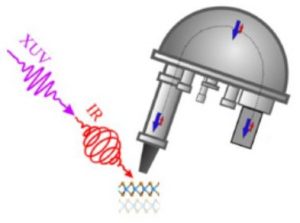The electron carries an elementary electric charge and a spin. With the advent of spintronics (or spin electronics), and the fact that spin can be the carrier of quantum information (qubit), research is continuing to better understand and control electron spin dynamics.
Through experiments carried out on the ATTOlab laser platform at LIDYL, CEA-Saclay, a collaboration of scientists has succeeded in studying the dynamics of ultra-rapid electron spin relaxation in a WSe2 crystal, a semiconductor whose two-dimensional sheet structure gives it a very specific electronic structure. The experimental set-up combines ultrafast laser pulses, generated by extreme nonlinear optics, and spin-resolved photoelectron spectroscopy.

Spintronics is a branch of electronics in which information is carried by the electron spin, the dynamics of which we are seeking to better understand and control. Once electrons have been successfully brought into the desired spin state, the internal dynamics of matter can cause the spin to change, which is detrimental to this type of application. However, ultrafast electron spin dynamics within matter remain difficult to observe. The present study shows that it is possible to study these ultrafast dynamics directly, using the photoelectric effect with femtosecond laser pulses and electron spectrometry.
The study brought together teams from the Centre Lasers Intenses et Applications (CELIA, CEA / CNRS / Université de Bordeaux), the Laboratoire Interactions, Dynamiques et Lasers (LIDYL, CEA / CNRS ) and the Laboratoire de Physique des Matériaux et Surfaces (Univ. Cergy), in collaboration with the Universities of Paris-Saclay, Beijing and West Bohemia (Czech Republic). The study focuses on the spin dynamics within the first atomic layers of a tungsten diselenide – WSe2– crystal, which features a two-dimensional lamellar structure (Van der Waals solid) like graphene, and a structural spin order within each sheet.
Electrons are initially polarized into a well-defined spin state by a circularly polarized ultra-brief laser pulse, which creates excitons (e-hole pairs). A second flash of high-energy light then photoelectrically ejects these electrons from the solid. An electron spectrometer, resolved in angle and spin, is used to analyze the emitted electrons. By finely modifying the femtosecond delay (qques 10-15 s) between the initial pulse (pump) and the probe pulse, it becomes possible to reconstruct the film of electron spin dynamics in the crystal.
The very specific electronic structure of WSe2, which is a semiconductor, presents “valley states” whose spin state is well defined. In this experiment, we were able to follow the ultra-fast dynamics of exciton diffusion according to the different spin and valley states of the electron. In particular, it was observed that the long relaxation time of the spin polarization of the excitonic electron in the Σ valley state is favorable for its use in a spintronic device.
Thus, beyond a thorough understanding of the ultrafast spin dynamics in these layered semiconductor materials, the study of these original systems shows properties capable of bearing potential original applications for electronics, spintronics and, more generally, sensors or communication technologies.
The publication of this work in the journal Physical Review Letters has been selected as an “Editors’ Suggestion”.
Reference:
Ultrafast hidden spin polarization dynamics of bright and dark excitons in 2H-WSe2,
M. Fanciulli, D. Bresteau, J. Gaudin, S. Dong, R. Géneaux, T. Ruchon, O. Tcherbakoff, J. Minár, O.Heckmann, M.-C. Richter, K. Hricovini and S. Beaulieu, Phys. Rev. Lett. 131, 066402 – Open archive: arXiv (July 2023)
CNRS/INP news:“Controlling ultrafast electron spin dynamics“.
CEA contact: David Bresteau (LIDYL/ATTO).
Collaboration :
- Laboratoire de Physique des Matériaux et Surfaces, CY Cergy Paris Université, 95031 Cergy-Pontoise, France
- Université Paris-Saclay, CEA, CNRS, LIDYL, Gif-sur-Yvette, 91191, France
- Université de Bordeaux-CNRS-CEA, CELIA, UMR5107, F33405 Talence, France
- Beijing National Laboratory for Condensed Matter Physics, Institute of Physics, Chinese Academy of Sciences, Beijing 100190, China
- University of West Bohemia, New Technologies Research Centre, 301 00 Plzeň, Czech Republic





